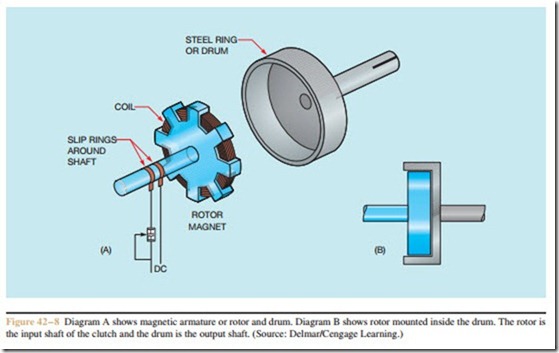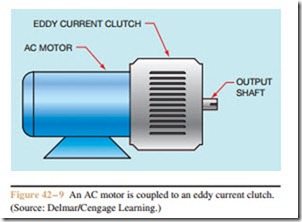Eddy Current Clutches
Eddy current clutches are so named because they in- duce eddy currents into a metal cylinder or drum. One part of the clutch contains slip rings and a winding
(Figure 42–8A). The armature or rotor is constructed so that when the winding is excited with direct current, magnetic pole pieces are formed. The rotor is mounted inside the metal drum that forms the output shaft of the clutch (Figure 42–8B). The rotor is the input of the clutch and is connected to an AC induction motor. The motor provides the turning force for the clutch (Figure 42–9). When direct current is applied to the rotor, the spinning electromagnets induce eddy currents into the metal drum. The induced eddy currents form magnetic poles inside the drum. The magnetic fields of the rotor and drum are attracted to each other, and the clutch turns in the same direction as the motor.
The main advantage of an eddy current clutch is that there is no mechanical connection between the rotor and drum. Since there is no mechanical connection, there is no friction to produce excessive heat and there is no wear as is the case with mechanical clutches.
The speed of the clutch can be controlled by varying the amount of direct current applied to the armature or rotor. Since the output speed is determined by the amount of slip between the rotor and drum, when load is added, the slip will become greater, causing a de- crease in speed. This can be compensated for by in- creasing the amount of direct current applied to the rotor. Many eddy current clutch circuits contain a speed sensing device that will automatically increase or decrease the DC excitation current when load is added or removed.
Review Questions
1. Does varying the voltage to an AC induction motor cause a change in synchronous speed?
2. Why do induction motors that are intended to be controlled by variable voltage contain high impedance stator windings?
3. What is the disadvantage of a motor that contains a high impedance stator winding?
4. What type of AC induction motor is used with variable voltage control when it is desirable for the motor to reverse direction?
5. What type of motor that can be controlled with variable voltage is used to operate power drills, vacuum cleaners, routers, etc.?
6. Why are universal motors so named?
Chapter 42 Variable Voltage and Magnetic Clutches 337
7. What type of solid-state component is generally used to control AC voltage?
8. When using a mechanical clutch, what determines how fast a load can be accelerated and the amount of initial torque applied to the load?
9. What is the primary advantage of an eddy current clutch over a mechanical clutch?
10. How is the speed of an eddy current clutch controlled?

